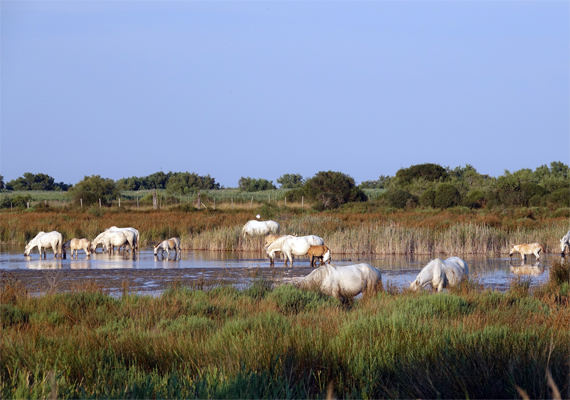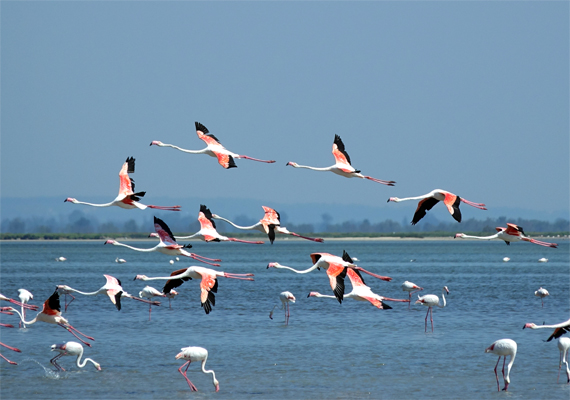The Camargue is a wide wetland between the Mediterranean sea and the two arms of the Rhone river. With an area of over 930 km2 (360 sq mi), it is western Europe's largest river delta, comprising large brine lagoons or étangs, cut off from the sea by sandbars and encircled by reed-covered marshes. These are in turn surrounded by a large cultivated area.
Humans have lived in the Camargue for millennia, greatly affecting it with drainage schemes, dykes, rice paddies and salt pans. Much of the outer Camargue has been drained for agricultural purposes.
At the end of the 18th century, they had the Rhône diked to protect the town and their properties from flooding. In 1859, the building of the "digue à la mer" (dyke to the sea) achieved temporary protection of the delta from erosion, but it is a changing landform, always affected by waters and weather. Gradually cereal, asparagus, grapevine and rice fields have been taking over the original landscapes.
Heading more south to discover a more authentic Camargue: there is a large range of different landscapes like flood plains, salt plains, ponds, woods and the Camargue's largest reed beds. These protected natural spaces ensure the ecological balance of the typical flora and fauna and also allows traditional breeding of Camargue bulls and horses.
Officially established as a regional park and nature reserve in 1975, the Parc Naturel Regional de Camargue covers 820 km² including the regions of Arles and Les Saintes Maries de la Mer. This territory is some of the most natural and most protected in all of Europe. A roadside museum, observation towers, guided tours, and touristic information boards provide background on flora, fauna, and the history of the area.
The central area around the shoreline of the Etang de Vaccarès has been protected as a regional park since 1927, in recognition of its great importance as a haven for wild birds. In 2008 it was incorporated into the larger Parc naturel régional de Camargue.
The Camargue is home to more than 400 species of birds and has been identified as an Important Bird Area (IBA) by BirdLife International, and one of the most important stopping-off point for migratory birds in Europe. Its brine ponds provide one of the few European habitats for the greater flamingo.
The people of Camargue are very proud of their culture and traditions and therefore organize many events all year long to keep them alive. They particularly enjoy the bull shows: bandido, abrivado, ferrades, Camargue bullfighting...
Few towns of any size have developed in the Camargue. Some of them are exceptional historically rich cities.
Its "capital" is Arles, located at the extreme north of the delta. A very bright city, full of colors and noises around the market. It still shows the magnificence of its past within the roman remains. In the heart of Provence, every living soul here is proud of their traditions and way of life, and passionately keeps passing it on over generations.
Aigues-Mortes, the city of Saint Louis, is one of the finest walled cities in France, rising up out of the marshes.
Les Saintes Maries de la Mer, capital of the fervent Camargue, typical and full of life, it is the destination of the annual Romani pilgrimage for the veneration of Saint Sara.
Summer vacationers from all over Europe will find here everything they can wish for. Long sandy beaches, marinas, harbors offer a large variety of sports and cultural activities : nautical sports, tennis, golf, casinos, movie theaters, festivals, concerts, exhibitions, all in a unique natural environment. Those resorts are named : Le Grau du Roi, La Grande Motte, Port Camargue, Carnon, Palavas les flots.






